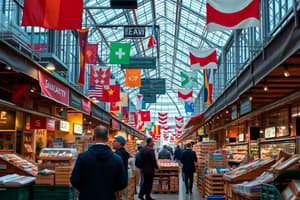Podcast
Questions and Answers
What is the primary focus of economics?
What is the primary focus of economics?
- The study of wealth distribution
- The impact of inflation on goods
- How to eliminate scarcity
- Allocating scarce resources to satisfy unlimited wants (correct)
What does opportunity cost refer to?
What does opportunity cost refer to?
- Monetary losses incurred during an economic downturn
- The next best alternative foregone when a decision is made (correct)
- The total cost of all resources used
- Costs associated with inflation
In which market type does a single seller dominate?
In which market type does a single seller dominate?
- Traditional Economy
- Oligopoly
- Monopoly (correct)
- Perfect Competition
What do leading economic indicators do?
What do leading economic indicators do?
Which of the following best describes a command economy?
Which of the following best describes a command economy?
Which statement accurately describes GDP?
Which statement accurately describes GDP?
What is the goal of monetary policy?
What is the goal of monetary policy?
What does inflation measure?
What does inflation measure?
Flashcards are hidden until you start studying
Study Notes
Economic Overview
- Definition: Economics is the study of how individuals and societies allocate scarce resources to satisfy unlimited wants.
Key Concepts
-
Scarcity:
- Limited availability of resources versus unlimited wants.
- Forces economies to make choices.
-
Opportunity Cost:
- The cost of the next best alternative that is forgone when a decision is made.
-
Supply and Demand:
- Supply: Amount of a good or service available for consumer purchase at various prices.
- Demand: Consumer's desire to purchase goods or services at various prices.
- Equilibrium: The point where supply equals demand.
-
Market Types:
- Perfect Competition: Many buyers and sellers, identical products.
- Monopoly: Single seller with significant market power.
- Oligopoly: Few sellers dominate the market.
-
Economic Systems:
- Traditional Economy: Based on customs and traditions.
- Command Economy: Central government controls production and distribution.
- Market Economy: Decisions based on supply and demand; less government intervention.
- Mixed Economy: Combination of market and command economies.
-
Gross Domestic Product (GDP):
- Total value of goods and services produced in a country in a given period.
- Indicators of economic health.
-
Inflation:
- The rate at which the general level of prices for goods and services rises.
- Measured by indexes like the Consumer Price Index (CPI).
-
Unemployment:
- The percentage of the labor force that is jobless and actively seeking employment.
-
Monetary Policy:
- Actions by a central bank to control the money supply and interest rates.
- Aimed at controlling inflation and stabilizing currency.
-
Fiscal Policy:
- Government spending and taxation decisions to influence the economy.
Economic Indicators
- Leading Indicators: Predict future economic activity (e.g., stock market performance).
- Lagging Indicators: Reflect changes after the economy has begun to follow a certain course (e.g., unemployment rates).
- Coincident Indicators: Occur at the same time as changes in the economy (e.g., GDP).
Current Issues in Economics
- Economic inequality: Disparity in wealth distribution.
- Globalization: Economic interdependence of countries.
- Sustainability: Balancing economic growth with environmental protection.
Economic Overview
- Economics studies how individuals and societies manage scarce resources to satisfy unlimited wants.
- It explores how choices are made, the trade-offs involved, and the consequences of those decisions.
Key Concepts
- Scarcity is the fundamental economic problem – limited resources versus unlimited wants, forcing choices.
- Opportunity Cost represents the value of the best alternative that is sacrificed when a decision is made.
- Supply and Demand:
- Supply is the quantity of a good or service available for purchase at various prices.
- Demand reflects consumers' willingness to purchase these goods or services at different prices.
- Equilibrium occurs when supply and demand intersect, determining the market price.
- Market Types:
- Perfect Competition: Many buyers and sellers trade identical products, with no single entity having significant control.
- Monopoly: A single seller dominates the market, leading to potential price manipulation.
- Oligopoly: A small number of sellers control a large market share, often resulting in strategic competition.
- Economic Systems:
- Traditional Economy: Production and distribution are determined by custom and tradition, often passed down through generations.
- Command Economy: The government centrally controls production and distribution of goods and services.
- Market Economy: Decisions are driven by supply and demand, with limited government intervention.
- Mixed Economy: A blend of market and command mechanisms, with varying levels of government intervention.
- Gross Domestic Product (GDP):
- Represents the total value of goods and services produced within a country during a specific period.
- It serves as a primary indicator of economic health and growth.
- Inflation:
- Reflects a sustained increase in the general price level of goods and services over time.
- It is measured by indexes like the Consumer Price Index (CPI).
- Unemployment:
- Represents the percentage of the labor force actively seeking employment but unable to find work.
- Monetary Policy:
- Refers to actions taken by central banks to manage the money supply and interest rates.
- These actions aim to control inflation and stabilize the value of the currency.
- Fiscal Policy:
- Involves government spending and taxation decisions to influence the economy.
- By adjusting these levers, the government can stimulate or restrain economic activity.
Economic Indicators
- Leading Indicators: These signals predict future economic activity, examples include stock market performance.
- Lagging Indicators: These reflect changes after the economy has started to follow a specific trend, such as unemployment rates.
- Coincident Indicators: These occur simultaneously with changes in the economy, like the Gross Domestic Product (GDP).
Current Issues in Economics
- Economic Inequality: The uneven distribution of wealth and income among individuals and groups.
- Globalization: The increasing interconnectedness of economies and the flow of goods, services, capital, and people across borders.
- Sustainability: The challenge of balancing economic growth with environmental protection and resource conservation.
Studying That Suits You
Use AI to generate personalized quizzes and flashcards to suit your learning preferences.




